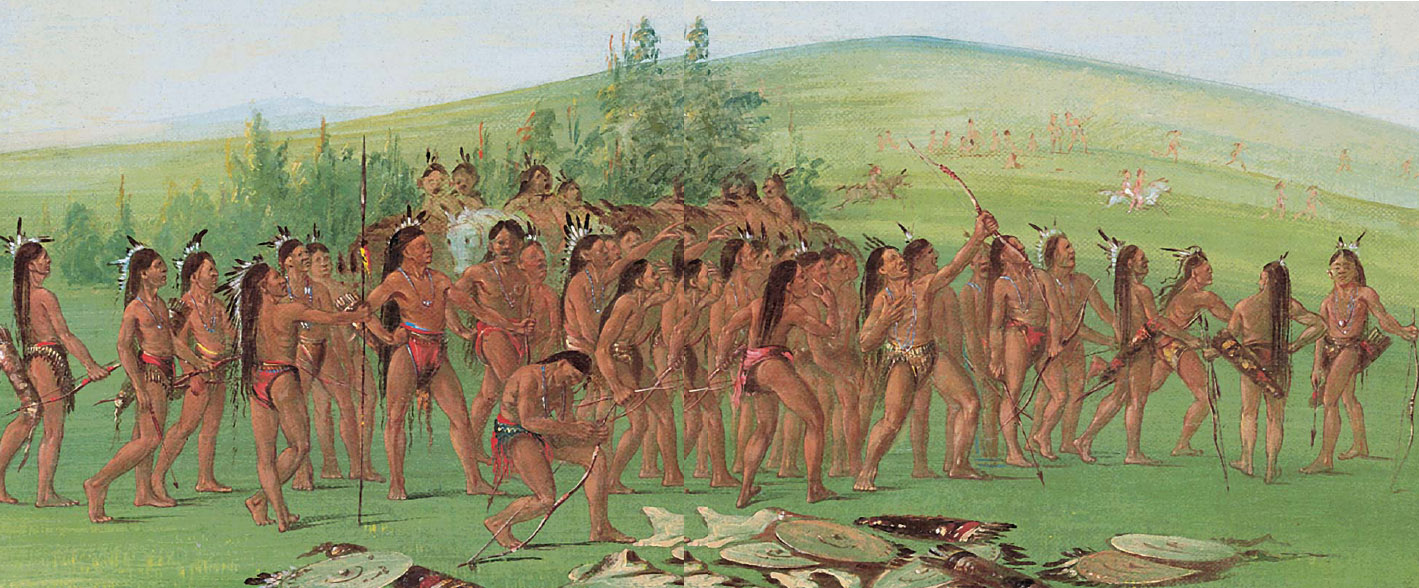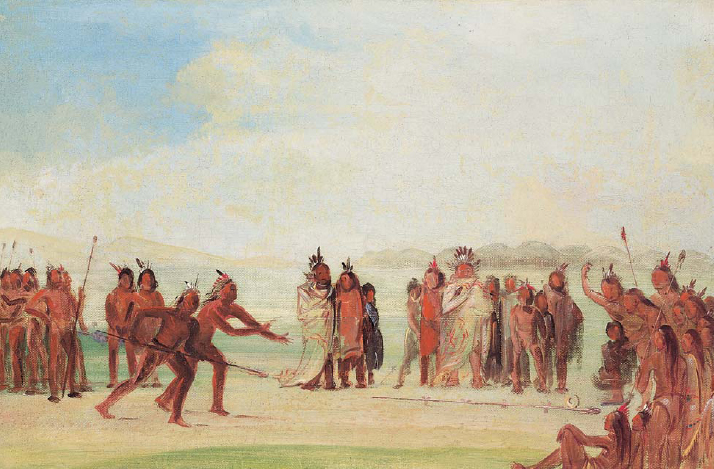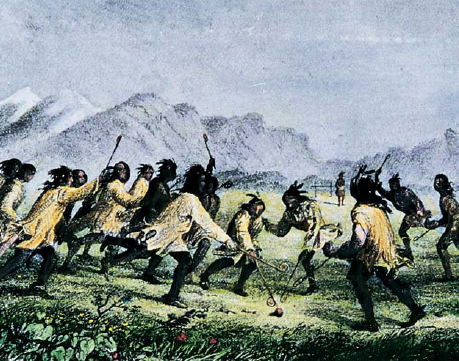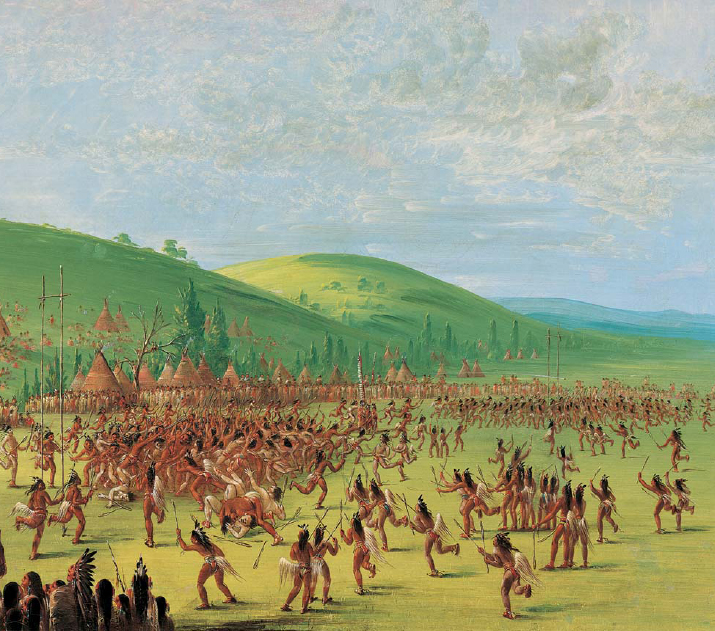
Mandan archery contests, like the one shown here, often hinged not on accuracy but on distance or on how many arrows a participant could shoot in the air before the first one touched the ground.
The sport for which the woodland Indians are best known is lacrosse. This team game was popular throughout northeastern America. Lacrosse meant different things to the tribes that played it. To the Menomini in Wisconsin, it was a war game. They believed the legendary Thunderer god, Manidog, gave it to men. Playing it brought strength and skill in battle. In Ontario, the Huron believed the game helped heal the sick.
Legends said that a god, the Thunderer, invented lacrosse. Therefore, a man whose guardian spirit was the Thunderbird would call for a game. This man didn’t play. He stayed on the sidelines as the game went on, praying and offering sacrifices. Before the game began, he would offer tobacco to the players. Then he chose the captains.
The captains picked their teams randomly. Every player had his own racket, which he decorated in his own way. Before the game, they would pile all their rackets together. One captain would be blindfolded. He would divide the rackets into two piles. These would be the two teams. The game was usually played with teams of five, but sometimes they swelled to as large as nine. Legends told of long-ago days when the game was played with nearly 100 people on each side.
Lacrosse rackets were made from sapling trees about four feet long. The saplings were bent into oval loops at the ends. The loops were then netted with leather thongs. The game was played on a field about a quarter mile long. Two goalposts were set at each end. The object was to get the ball between the posts. Each team had a goalie protecting its goal. Some tribes, including the Ojibwa, used only one goalpost on each side. Players had to hit the goalpost with the ball or their racket. Players would move the ball up the field, passing it to each other. It was illegal to touch the ball with the hands—players could use only their rackets.

Mandan archery contests, like the one shown here, often hinged not on accuracy but on distance or on how many arrows a participant could shoot in the air before the first one touched the ground.

Many tribes played variations of the game depicted in this painting. The object was to throw a spear or javelin through a rolling ring.
Lacrosse games were rough. It wasn’t unusual for a player to break an arm or a leg, and bruises were expected. The games were played until a set number of goals was scored. It was usually five, but the game sponsor could change that when he began the game. Sometimes, a game would run all day. In many tribes, the sponsor gave a prize to each player who scored. The player would then give it to a woman on the sidelines. It was usually his aunt or another relative. After the game, they would give him a different prize.
Lacrosse originated as a religious ceremony, and it was often played as a contest between tribes. For many years, no one bet on lacrosse. As time passed, however, the game lost some of its religious significance and began to be played for fun. When this happened, people wagered on the winner. Some would even bet on each goal scored.
Only men played lacrosse. Women played a similar game called double ball. It was played with two buckskin balls joined by an eightinch leather strap. Players could snag the double-ball strap with their sticks and pass it to their teammates. Team size and equipment varied. The sticks were usually curved and never had a pouch. The Potowatomi played with five to a side and one straight stick. Chippewa teams had more players. Each Chippewa player used two sticks, which were curved at the ends.
Double ball had a goalpost on each end of a 300-foot field, guarded by a goalie. The object of the game was to hit the post with the ball or a stick. As in lacrosse, gifts were awarded every time someone scored. The players would give their prizes to a man watching the game. He would repay them for the gifts later.
Men in the Northeast enjoyed many active games, such as wrestling, foot racing, and bow shooting. One of their strangest games was the kick fight, played by the Menomini and Winnebago Indians. The game would start suddenly. Someone in a group would shout the game’s name, Ato’wi, and the game would be on. Men would kick each other in the buttocks as hard as they could. When someone lost his temper or cried out in pain, he would drop out of the game. The winner was the man who could maintain his composure the longest.
Lacrosse wasn’t always played on a large field. In the winter, games were sometimes played on frozen lakes. The slippery ice made the game even rougher.
A gentler game, though just as popular, was the moccasin game. Like a modern shell game, it was a guessing game that people gambled on. Someone would hide four stones in four different moccasins. One stone would be marked. The player would have to guess which moccasin the marked stone was in. While he guessed, onlookers sang a repetitive song.
This game varied among the tribes. In Kansas, the Potowatomi hid only one stone, rather than four. In some tribes, including the Chippewa, Winnebago, and Menomini, players used striking sticks to guess. The guesser would look at the moccasins carefully. When he thought he knew where the stone was, he would swat his choice with the stick.
Potowatomi men and women also gambled on dice games, but rarely together. A blanket would be spread out for throwing the dice. There were eight dice, carved from buffalo ribs. Six were circular disks with one colored side. Of the two remaining, one was shaped like a turtle, and another like a horse’s head. Players would shake them in a basket and toss them onto the blanket. The roller would get points for how many dice came up the same color. Players used beans to keep score.
Some games spread across the country. Most Native Americans enjoyed games with hoops and poles. There were many different variations of the game, changing with the area. In New York, the Seneca called it the game of the javelins, or ga-na-ga-o. Two teams would line up, one on each side of a field. Each player had the same number of javelins. A six-inch hoop would be rolled in front of the first team’s line. Players on the first team would try to throw their javelins through the hoop. The throwing team got to keep the javelins that made it through. Their opponents picked up the shots that missed.
Then, the hoop was rolled in front of the second team. They would all take a shot. Their misses would go to the first team. This would continue until one team had all the javelins.
Often, a crowd would gather around dice games. They would cheer, “Hub, hub, hub!” This noise is where we get the word hubbub, meaning a commotion.
Another throwing game was called snow snake. Many tribes played this game, although it was particularly popular among the Iroquois tribes. In the winter, men and boys would prepare ice ramps and tracks for playing the game. They would drag logs to make long channels in the snow. Some Iroquois tracks were a mile long.
In 1763, a group of Ottawa Indians played lacrosse outside of Fort Michilmackinac in Michigan. The British soldiers inside the fort thought it was an innocent game. Then, someone knocked the ball near the gate of the fort. The players rushed to get it. Suddenly, the game changed. Instead of putting the ball in play, the players attacked the guards. They quickly overpowered them and swarmed inside. The entire fort was caught off guard. After the battle, the Ottawas took over the fort.
The Ottawa chief, Pontiac, had planned the clever sneak attack in advance. The fort’s commanding officer had heard there would be a sneak attack. However, he ignored the report, thinking it was just a nervous rumor. That year, Pontiac took over nine English forts.

To play, players used hardwood sticks. The sticks, which could be anywhere from two to six feet long, were carved and decorated to look like a snake. Many would have a knob at one end, representing the head.
Players would balance the snake on one hand, steadying it with the other. They would run a few steps and flip the snake into the air. The snake would land and slide on the ice-covered track. The winner was the player whose snake slid the farthest. An experienced thrower could send his snake quite a long way! §

In the Southeast, lacrosse games often pitted one village or tribe against another and sometimes included hundreds of players. These games could get quite rough.